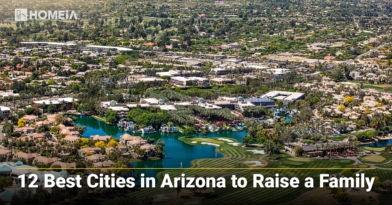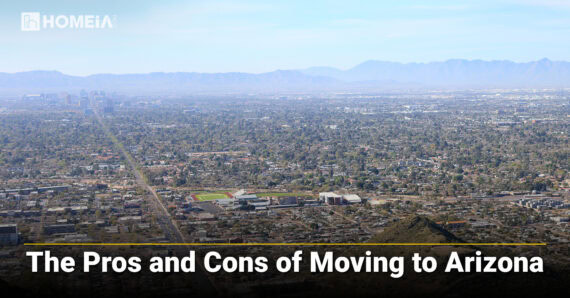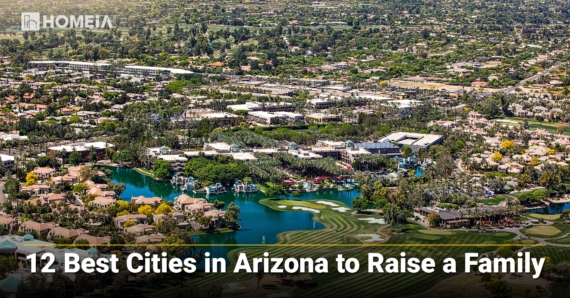7 Best Places to Live in Arizona in 2025
- Local Editor:Local Editor: Gwen Parrish
Published: Apr 14, 2025
- Category: City Living Guide
Relocating to Arizona offers a unique combination of natural beauty, economic opportunity, and diverse lifestyle options. The Grand Canyon State features stunning desert landscapes, mountain ranges, and over 300 days of sunshine annually. From bustling metropolitan areas to quiet suburban communities, Arizona attracts residents seeking warm weather, outdoor recreation, and a lower cost of living than neighboring California.
With no state income tax on Social Security benefits, Arizona appeals to retirees, while families appreciate the expanding job market and educational opportunities throughout the state.
Among the best places to live in Arizona are Phoenix, Tucson, Scottsdale, Gilbert, and Chandler—each offering its own distinct advantages for newcomers. Read on to discover which city might be the perfect fit for your lifestyle and priorities.
12 Best Cities to Live in Arizona for Families
We took 4 main variables into consideration to determine the best places in Arizona to raise a family. The variables are quality of education, health care, personal safety, and recreational opportunities. Here you’ll find our list, along with the highlights that make each Arizona locale a special place to raise a family…
Table of Contents:
1. Tucson, AZ
HOMEiA Score: 77/100
- Cost of Living: 3% below the U.S. national average
- Home price to income ratio: $323,000/$45,000 = 7.18 (buying homes is extremely expensive)
- Income to rent ratio: $45,000/$12,000 = 3.75 (renting homes is affordable)
Tucson, Arizona’s second-largest city, offers a distinctive blend of Southwestern culture, natural beauty, and urban amenities. Located in a desert valley surrounded by five mountain ranges, Tucson combines rich multicultural heritage with a relaxed lifestyle and affordable cost of living.
A. Size and Population
Tucson has a population of approximately 548,722 (2025) spread over a 227-square-mile area. The population density is moderate at about 2,417 people per square mile.
The population grew by approximately 5.8% from 2020 through 2025, slightly below the U.S. growth rate, reflecting Tucson’s different economic profile and development patterns compared to Phoenix.
B. Median Income, Cost of Living and Housing Market Characteristics
TUCSON MEDIAN HOUSEHOLD INCOME (2025): $45,000
Tucson Cost of Living, Arizona:
- 3% Lower than the U.S. National Average
- 13% Lower than Phoenix, Arizona
- 36% Lower than Scottsdale, Arizona
- 18% Lower than Denver, Colorado
Tucson Housing Costs
- Median Home Value: $323,000
- Annual Spend for Homeowners: $18,000
- Annual Spend for Renters (Rent & Utilities): $12,000
Tucson shows a home price-to-income ratio of 7.18, making homebuying extremely expensive relative to local incomes. With an income-to-rent ratio of 3.75, renting remains affordable. Approximately 52.3% of residents own their homes.
C. Top Neighborhoods in Tucson, AZ:
- Catalina Foothills (Average Home Value: $500,000 to $2+ million)
Offers stunning mountain views, luxury homes, and proximity to Sabino Canyon Recreation Area with excellent schools.
- Sam Hughes (Average Home Value: $400,000 to $900,000)
A historic neighborhood adjacent to the University of Arizona with charming 1920s and 1930s homes and walkable amenities.
- Civano (Average Home Value: $300,000 to $600,000)
A planned community designed with sustainability featuring energy-efficient homes, community gardens, and a pedestrian-friendly layout.
- El Encanto/Colonia Solana (Average Home Value: $600,000 to $1.5+ million)
Adjacent historic neighborhoods with elegant Spanish Colonial and Mission Revival homes on large lots with mature landscaping.
- Dove Mountain (Average Home Value: $350,000 to $1.2+ million)
A resort-style community in neighboring Marana featuring golf courses, hiking trails, and luxury amenities.
D. Employment Prospects
The unemployment rate in Tucson is approximately 4.1% (January 2025), above national and state rates. The poverty rate is 22.5%, well above state and national averages, though varying significantly by neighborhood.
Top employers include the University of Arizona, Raytheon Missiles & Defense, Davis-Monthan Air Force Base, Banner Health, and Tucson Unified School District.
The average commute time is 24 minutes, slightly below the national average, facilitated by the city’s grid layout.
5 Safest and Most Affordable Cities to Live in Arizona (Updated)
Arizona, the Country’s forty-eighth state, has breathtaking desert landscapes, striking mountain ranges, and vibrant local communities. All this combines to offer a distinctive blend of natural beauty and a choice of rural or urban living…
E. Unique Attributes and Lifestyle
Tucson offers a distinctive Southwestern lifestyle:
- Sonoran Desert Setting: Surrounded by stunning desert landscapes, including Saguaro National Park with its iconic cacti, The Sonoran Desert Museum with native animals in natural habitats, and five mountain ranges providing numerous outdoor recreation opportunities.
- Cultural Heritage: Strong Mexican and Native American influences are evident in architecture, cuisine, and traditions, with events like the Tucson International Mariachi Conference and All Souls Procession.
- Astronomy Center: A world-renowned center for astronomy research with the University of Arizona’s Steward Observatory and nearby Kitt Peak National Observatory, supported by dark sky ordinances.
- Culinary Destination: Designated the first UNESCO City of Gastronomy in the United States, recognizing its 4,000-year food heritage combining Mexican, Native American, and international influences.
- Arts Scene: Home to the Tucson Museum of Art, Center for Creative Photography, and numerous galleries in the Warehouse Arts District, plus a diverse music scene.
F. Education
Tucson is served by multiple school districts, with Tucson Unified School District being the largest. Top-performing public high schools include University High School, Catalina Foothills High School, and Sabino High School.
Higher education is centered around the University of Arizona, a major research institution with strengths in astronomy, optics, and environmental science.
The high school graduation rate is approximately 82%, below the U.S. national average, with about 32% of adults holding college degrees.
G. Healthcare and Safety
Tucson is served by several major healthcare systems, including Banner-University Medical Center, Tucson Medical Center, and Carondelet St. Joseph’s Hospital.
The city has 7.18 violent crimes per 1,000 residents and 39.5 property crimes per 1,000 residents, both well above state and national medians, though rates vary significantly by neighborhood.
Recommended for you
2. Flagstaff, AZ
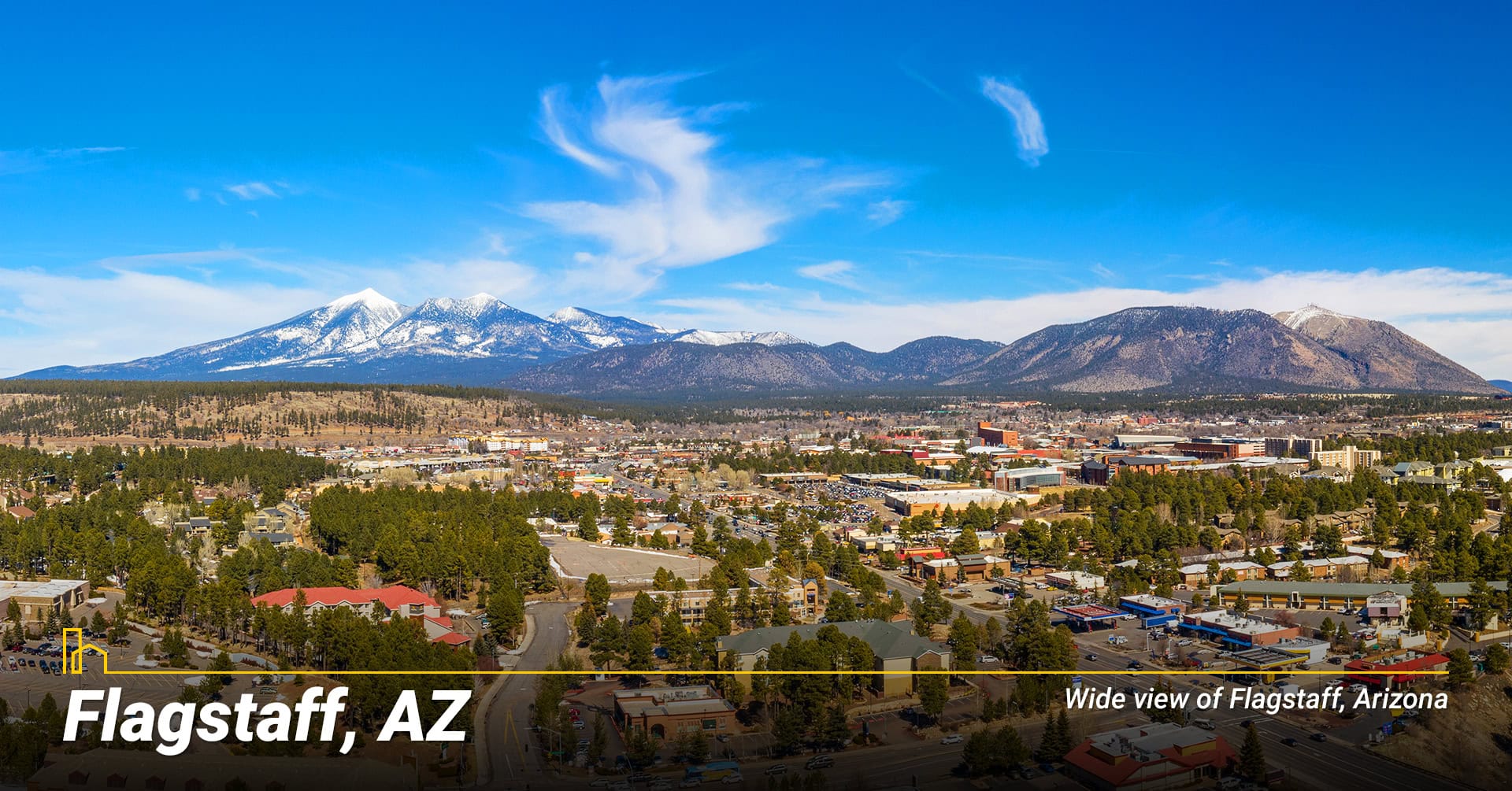
HOMEiA Score: 78/100
- Cost of Living: 20% above the U.S. national average
- Home price to income ratio: $475,000/$58,000 = 8.19 (buying homes is very expensive)
- Income to rent ratio: $58,000/$17,400 = 3.33 (renting homes is affordable)
Flagstaff, nestled in northern Arizona’s ponderosa pine forests at 7,000 feet elevation, offers a mountain town atmosphere distinct from Arizona’s desert cities. With four seasons including snowy winters, Flagstaff attracts outdoor enthusiasts and combines a college-town vibe with a strong environmental ethos.
A. Size and Population
Flagstaff has a population of approximately 76,246 (2025) spread over a 64-square-mile area. The population density is moderate at about 1,076 people per square mile.
The population grew by approximately 7.5% from 2020 through 2025, reflecting Flagstaff’s appeal as a mountain community with educational opportunities and outdoor amenities.
B. Median Income, Cost of Living and Housing Market Characteristics
FLAGSTAFF MEDIAN HOUSEHOLD INCOME (2024): $68,000
Flagstaff Cost of Living, Arizona:
- 20% Higher than the U.S. National Average
- 10% Higher than Phoenix, Arizona
- 13% Lower than Scottsdale, Arizona
- 5% Higher than Denver, Colorado
Flagstaff Housing Costs
- Median Home Value: $475,000
- Annual Spend for Homeowners: $28,800
- Annual Spend for Renters (Rent & Utilities): $17,400
Flagstaff shows a home price-to-income ratio of 8.19, the least affordable housing market in Arizona relative to local incomes. With an income-to-rent ratio of 3.33, rent remains affordable. Approximately 47.2% of residents own their homes.
C. Top Neighborhoods in Flagstaff, AZ:
- Cheshire (Average Home Value: $550,000 to $1.2+ million)
An established neighborhood with custom homes on larger lots with mature pines and mountain views in northwest Flagstaff.
- Continental Country Club (Average Home Value: $450,000 to $1+ million)
A golf course community on Flagstaff’s east side features amenities including an 18-hole golf course, tennis courts, and pools.
- Ponderosa Trails (Average Home Value: $450,000 to $800,000)
A family-friendly neighborhood in southeast Flagstaff is known for excellent schools, well-maintained homes, and trail access.
- Historic Downtown (Average Home Value: $400,000 to $900,000)
Offering character-rich properties including renovated bungalows and Victorian homes with walkability to restaurants, shops, and galleries.
- University Heights/Elk Run (Average Home Value: $400,000 to $700,000)
Adjacent neighborhoods near Northern Arizona University with a mix of housing styles and good access to urban amenities.
An Ultimate Guide to Moving for Home Buyers and Sellers
Buying and selling a home doesn’t make you an expert in moving. Buying and selling are much more different when you’re actually moving. Carefully go through the tips listed below and uses these as your ultimate guide whenever moving…
D. Employment Prospects
The unemployment rate in Flagstaff is approximately 4.3% (January 2025), above national and state rates. The poverty rate is 23.6%, influenced partly by the large student population.
Top employers include Northern Arizona University, Flagstaff Medical Center, W.L. Gore & Associates, and the City of Flagstaff, with tourism and hospitality also significant.
The average commute time is just 18 minutes, well below the national average, facilitated by the city’s compact nature.
E. Unique Attributes and Lifestyle
Flagstaff offers a distinctive mountain lifestyle:
- Four Seasons: Unlike most of Arizona, Flagstaff experiences distinct seasons with snowy winters and mild summers, averaging over 100 inches of snowfall annually.
- Outdoor Recreation: Access to diverse activities including hiking in Coconino National Forest, mountain biking, rock climbing, and skiing at Arizona Snowbowl, with over 50 miles of urban trails.
- Astronomy and Dark Skies: Designated the world’s first International Dark Sky City in 2001, home to Lowell Observatory which discovered Pluto.
- Craft Beer Scene: Known for quality craft breweries including Historic Brewing Company, Mother Road Brewing, and Flagstaff Brewing Company.
- Cultural Diversity: Influenced by proximity to Navajo, Hopi, and other Native American nations, with the Museum of Northern Arizona displaying regional heritage.
F. Education
Flagstaff is primarily served by the Flagstaff Unified School District. Notable schools include Flagstaff High School, Coconino High School, and charter options like Northland Preparatory Academy and Basis Flagstaff.
Higher education is available at Northern Arizona University. With over 29,000 students, NAU is known for programs in education, forestry, and hotel management.
The high school graduation rate is approximately 86%, with about 45% of adults holding college degrees, well above the national average.
G. Healthcare and Safety
Flagstaff is served primarily by Flagstaff Medical Center, a Level I Trauma Center providing comprehensive healthcare services for northern Arizona.
The city has 3.65 violent crimes per 1,000 residents and 32.8 property crimes per 1,000 residents, with rates influenced by its role as a regional center and tourist destination.
The Pros and Cons of Moving to Arizona in 2025
If you are considering moving to Arizona, you’re in the right place! Known for its stunning desert landscapes, vibrant cities, and warm climate, Arizona offers a fantastic environment for living, working, and raising a family. State 48 has a diverse range of outdoor activities, from hiking in the Grand Canyon to exploring the red rocks of Sedona…
3. Phoenix, AZ
HOMEiA Score: 80/100
- Cost of Living: 12% above the U.S. national average
- Home price to income ratio: $400,000/$70,000 = 5.71 (buying homes is expensive)
- Income to rent ratio: $70,000/$17,400 = 4.02 (renting homes is affordable)
Phoenix, Arizona’s capital and largest city, anchors the Valley of the Sun metropolitan area. As the fifth-largest city in the United States, Phoenix offers diverse neighborhoods, cultural attractions, and recreational opportunities with a thriving arts scene making it increasingly attractive for relocators.
A. Size and Population
Phoenix has a population of approximately 1.8 million (2024) spread over a 517-square-mile area. The population density is moderate at about 3,289 people per square mile, varying across neighborhoods.
The population grew by approximately 9.7% from 2020 through 2024, above the U.S. growth rate, reflecting Phoenix’s strong economy and relative affordability compared to coastal cities.
B. Median Income, Cost of Living and Housing Market Characteristics
PHOENIX MEDIAN HOUSEHOLD INCOME (2024): $70,000
Phoenix Cost of Living, Arizona:
- 10% Higher than the U.S. National Average
- 23% Lower than Scottsdale, Arizona
- 42% Lower than San Francisco, California
- 3% Lower than Denver, Colorado
Phoenix Housing Costs
- Median Home Value: $400,000
- Annual Spend for Homeowners: $25,600
- Annual Spend for Renters (Rent & Utilities): $17,400
Phoenix shows a home price-to-income ratio of 5.71, making homebuying expensive. With an income-to-rent ratio of 4.02, renting is affordable. Approximately 56.1% of residents own their homes.
C. Top Neighborhoods in Phoenix, AZ:
- Arcadia (Average Home Value: $800,000 to $3+ million)
An upscale neighborhood with large lots, mature landscaping, and citrus trees offering stunning views of Camelback Mountain.
- Biltmore Area (Average Home Value: $600,000 to $2.5+ million)
A prestigious neighborhood centered around the historic Arizona Biltmore Resort featuring luxury homes and upscale amenities.
- North Central Phoenix (Average Home Value: $500,000 to $2+ million)
Characterized by historic homes, tree-lined streets, and a keen sense of community with diverse architectural styles.
- Desert Ridge (Average Home Value: $450,000 to $1.2+ million)
An expert-planned community in northeast Phoenix with modern homes, shopping destinations, and recreational amenities.
- Roosevelt Row (Average Home Value: $350,000 to $1+ million)
A vibrant arts district in downtown Phoenix offering historic homes, modern condominiums, galleries, restaurants, and nightlife.
How to Sell a House in Arizona?
One of the biggest advantages for homeowners in Arizona is that they can sell their property, i.e., a home without the need of a lawyer. Some other states require that buyers and sellers meet up to negotiate to close the deal. In Arizona, a home can easily close escrow, and both parties don’t even have to meet…
D. Employment Prospects
The unemployment rate in Phoenix is approximately 3.3% (January 2025), close to national and state rates. The poverty rate stands at 16.2%, above state and national averages, though varying significantly by neighborhood.
Top employers include Banner Health, Arizona State University, Amazon, Dignity Health, and Intel. The city has a diverse economy with strengths in healthcare, education, technology, financial services, and tourism.
The average commute time is 27 minutes, close to the national average, facilitated by the city’s grid layout and extensive freeway system.
E. Unique Attributes and Lifestyle
Phoenix offers an urban experience in a desert setting:
- Desert Botanical Garden: A 140-acre garden showcasing desert plants with specialized collections and seasonal exhibits.
- Arts and Culture: Home to the Phoenix Art Museum, Heard Museum, and Musical Instrument Museum, with a growing performing arts scene around the Phoenix Symphony and Arizona Opera.
- Outdoor Recreation: Despite its urban environment, Phoenix offers 41,000+ acres of desert parks and mountain preserves, including Camelback Mountain, Piestewa Peak, and South Mountain Park.
- Professional Sports: Home to teams in all four major professional leagues: Arizona Cardinals (NFL), Phoenix Suns (NBA), Arizona Diamondbacks (MLB), and Arizona Coyotes (NHL).
- Dining and Nightlife: A rapidly evolving culinary scene with award-winning restaurants, innovative chefs, and diverse international cuisine.
F. Education
Phoenix is served by multiple school districts, with quality varying across the city. Top-performing public high schools include Desert Vista High School, Sunnyslope High School, and North High School.
Higher education options include Arizona State University’s Downtown Phoenix campus, University of Arizona College of Medicine-Phoenix, Grand Canyon University, and multiple community colleges.
The high school graduation rate is approximately 86%, slightly below the U.S. national average, with about 30% of adults holding college degrees.
G. Healthcare and Safety
Phoenix is served by several major healthcare systems, including Banner Health, Dignity Health, Mayo Clinic, and HonorHealth.
The city has 7.25 violent crimes per 1,000 residents and 34.5 property crimes per 1,000 residents, both above state and national medians. Crime rates vary significantly by neighborhood, with some areas experiencing incredibly low crime while others face more challenges.
Recommended for you
4. Tempe, AZ
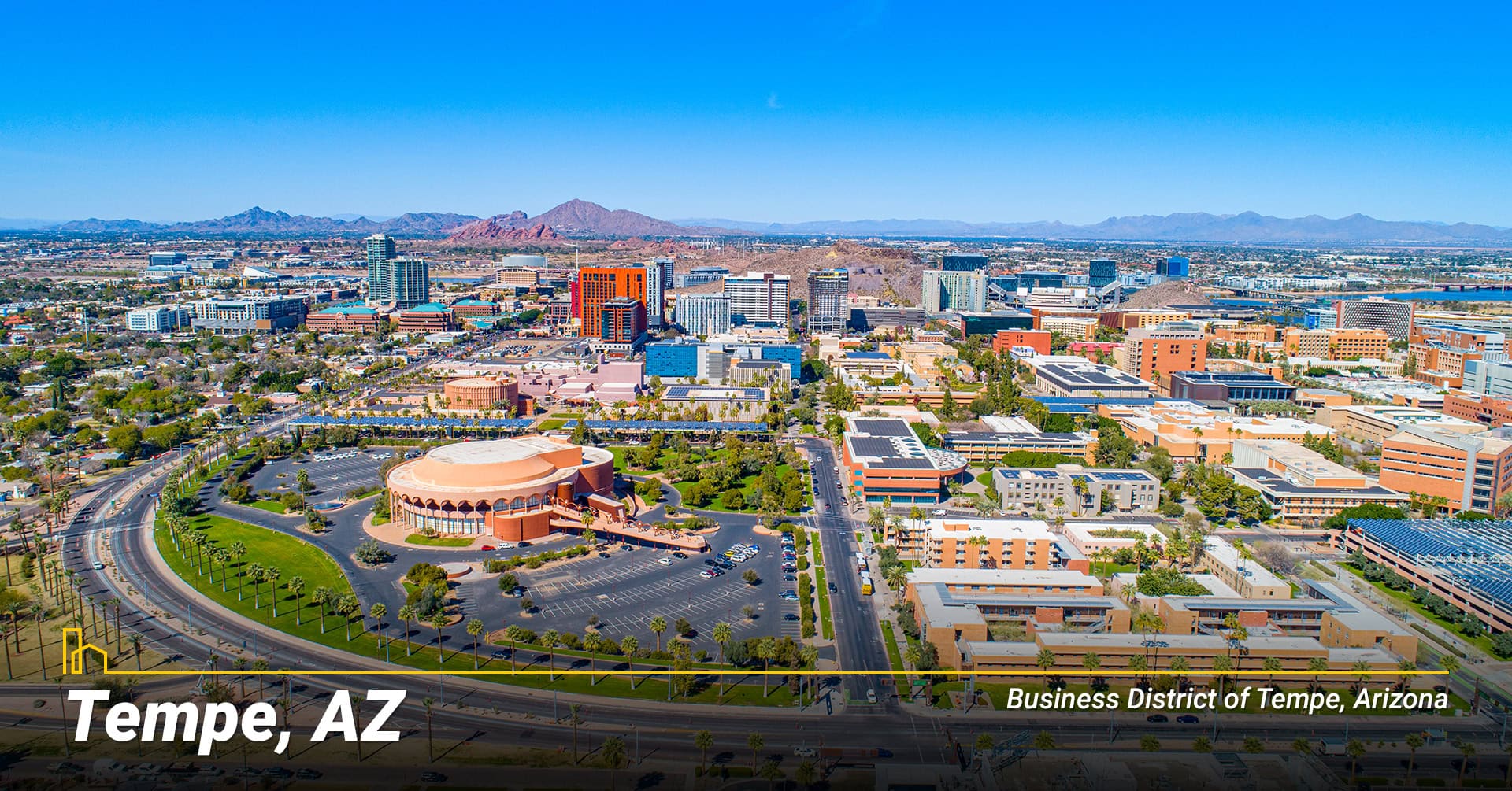
HOMEiA Score: 82/100
- Cost of Living: 12% above the U.S. national average
- Home price to income ratio: $385,000/$60,000 = 6.42 (buying homes is expensive)
- Income to rent ratio: $60,000/$16,800 = 3.57 (renting homes is affordable)
Tempe offers a dynamic blend of university-town energy and urban amenities. Home to Arizona State University’s main campus, Tempe features a youthful atmosphere, vibrant cultural scene, and growing technology sector, making it particularly attractive to students, young professionals, and those seeking an active lifestyle.
A. Size and Population
Tempe has a population of approximately 193,000 (2024) spread over a 40-square-mile area. The population density is high at about 4,825 people per square mile, reflecting the city’s urban character.
The population grew by approximately 7.4% from 2020 through 2024, influenced by Arizona State University’s expansion and Tempe’s emergence as a technology and employment hub.
B. Median Income, Cost of Living and Housing Market Characteristics
TEMPE MEDIAN HOUSEHOLD INCOME (2024): $60,000
Tempe Cost of Living, Arizona:
- 12% Higher than the U.S. National Average
- 2% Higher than Phoenix, Arizona
- 21% Lower than Scottsdale, Arizona
- 3% Lower than Denver, Colorado
Tempe Housing Costs
- Median Home Value: $385,000
- Annual Spend for Homeowners: $25,200
- Annual Spend for Renters (Rent & Utilities): $16,800
Tempe shows a home price-to-income ratio of 6.55, making homebuying expensive. With an income-to-rent ratio of 3.72, rent remains affordable. Approximately 41.5% of residents own their homes, a lower rate than many Arizona cities due partly to the large student population.
C. Top Neighborhoods in Tempe, AZ:
- Tempe Gardens (Average Home Value: $450,000 to $800,000)
An established neighborhood with mid-century homes on large lots near ASU and downtown Tempe, popular with professionals and faculty.
- Warner Ranch (Average Home Value: $400,000 to $700,000)
A planned community in south Tempe known for its family-friendly atmosphere, excellent schools, parks, and walking paths.
- Broadmor (Average Home Value: $500,000 to $900,000)
A historic neighborhood featuring charming 1950s and 1960s homes with tree-lined streets and proximity to downtown amenities.
- The Lakes (Average Home Value: $400,000 to $1+ million)
A community built around man-made lakes offering recreational opportunities and scenic views with a variety of housing styles.
- South Tempe (Average Home Value: $400,000 to $800,000)
Encompasses several subdivisions known for their suburban atmosphere, larger homes, and family-friendly amenities.
10 Most Affordable Places to Live in California: 2025
California, known as the Golden State, is as famous for its natural beauty and geographic diversity as it is for making people’s Hollywood dreams come true. What many house hunters don’t realize is you can live well in California without having to spend all your time working to balance your budget…
D. Employment Prospects
The unemployment rate in Tempe is approximately 3.1% (January 2025), close to national and state rates. The poverty rate is 20.8%, though this figure is influenced by the large student population.
Top employers include Arizona State University, State Farm, Freedom Financial Network, JPMorgan Chase, and Microsoft. Tempe has established itself as a technology hub with the ASU Research Park and Tempe Town Lake business corridor.
The average commute time is just 22 minutes, below the national average, supported by the city’s central location, light rail system, and bicycle infrastructure.
E. Unique Attributes and Lifestyle
Tempe blends college-town energy with outdoor recreation and urban amenities:
- Tempe Town Lake: A 2-mile-long recreational lake offering boating, kayaking, paddleboarding, and fishing, with surrounding parks hosting concerts, festivals, and sporting events.
- Mill Avenue District: Downtown Tempe’s main thoroughfare features restaurants, bars, shops, and entertainment venues, hosting community events like the Tempe Festival of the Arts.
- Arts and Culture: ASU’s cultural venues provide performances, exhibitions, and events, including the Frank Lloyd Wright-designed ASU Gammage Auditorium hosting Broadway tours.
- Outdoor Recreation: Over 50 parks with sports fields, swimming pools, and recreation centers, plus nearby Papago Park with distinctive red rock formations and hiking trails.
- College Sports: Arizona State University’s Sun Devils compete in the Pac-12 conference, providing access to college football, basketball, baseball, and Olympic sports.
F. Education
Tempe is served primarily by the Tempe Union High School District and Tempe Elementary School District. Notable public high schools include Tempe High School, McClintock High School, and Corona del Sol High School.
Higher education is centered around Arizona State University, one of the largest public universities in the United States, with over 74,000 students on the Tempe campus.
The high school graduation rate is approximately 85%, slightly below the U.S. national average, with about 46% of adults holding college degrees, well above the national average.
G. Healthcare and Safety
Tempe is served by Tempe St. Luke’s Hospital and nearby Banner Desert Medical Center in Mesa, plus proximity to major Phoenix healthcare systems.
The city has 4.32 violent crimes per 1,000 residents and 28.7 property crimes per 1,000 residents, both above state and national medians, influenced by its urban character and university environment.
10 Cheapest Places to Live in California
We assessed the cost of living across Californian cities and compared them to the national average. The cost of living is calculated based on 5 main categories: housing, food, healthcare, transportation and energy. Based on these calculations, we narrowed down the list to California’s 10 most affordable cities…
5. Chandler, AZ
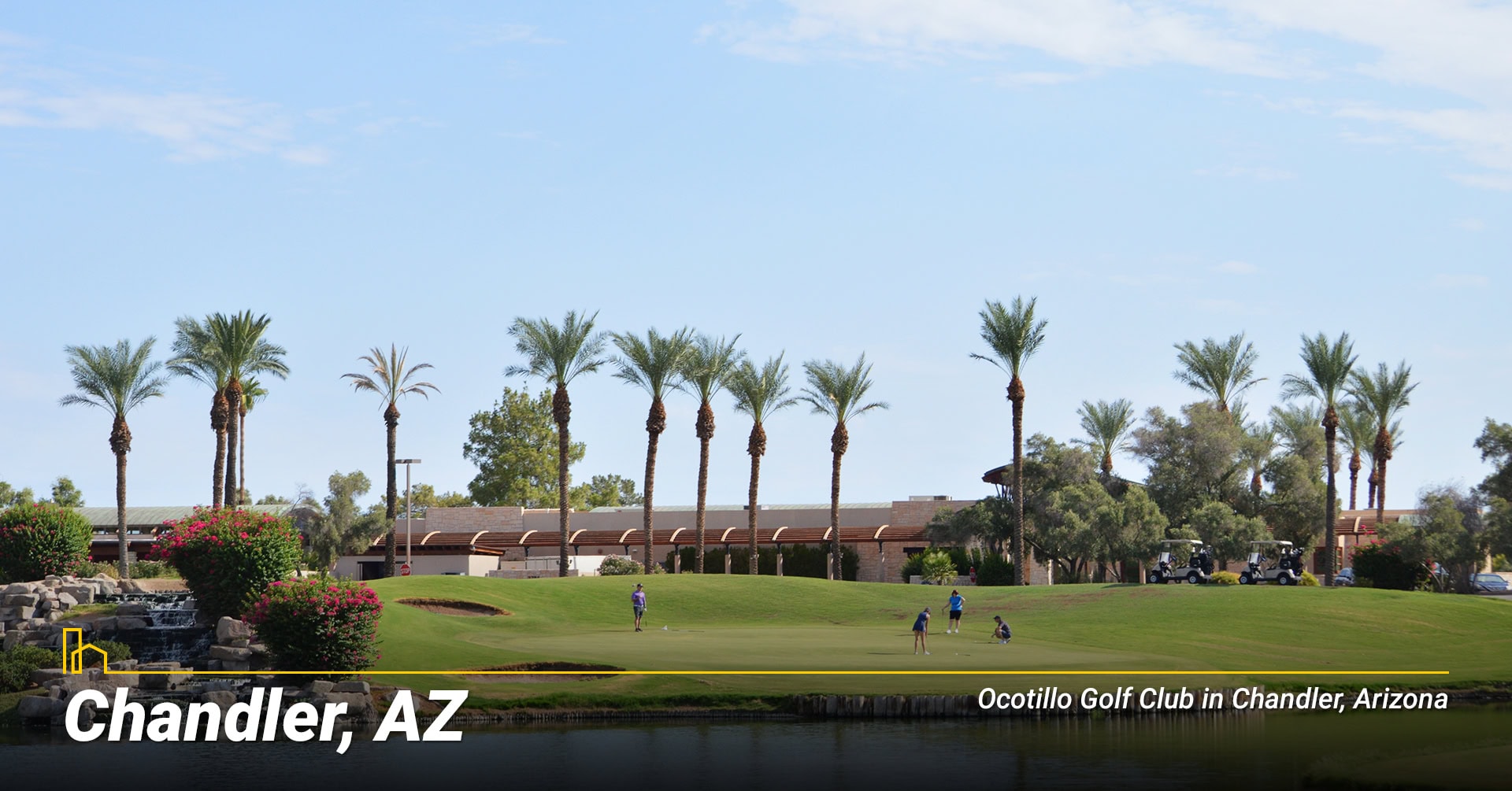
HOMEiA Score: 89/100
- Cost of Living: 15% above the U.S. national average
- Home price to income ratio: $425,000/$87,200 = 4.87 (buying homes is expensive)
- Income to rent ratio: $87,200/$18,000 = 4.84 (renting homes is affordable)
Chandler has evolved from a small agricultural town to a dynamic city known for technology and innovation. Home to major tech companies and manufacturing facilities, Chandler offers a strong economy, diverse neighborhoods, and excellent amenities, making it attractive for professionals and families.
A. Size and Population
Chandler has a population of approximately 289,934 (2025) spread over a 65-square-mile area. The population density is moderate at about 4,292 people per square mile.
The population grew by approximately 8.2% from 2020 through 2025, above the overall U.S. growth rate, reflecting Chandler’s appeal as a technology hub with family-friendly neighborhoods.
B. Median Income, Cost of Living and Housing Market Characteristics
CHANDLER MEDIAN HOUSEHOLD INCOME (2024): $87,200
Chandler Cost of Living, Arizona:
- 15% Higher than the U.S. National Average
- 2% Higher than Phoenix, Arizona
- 38% Lower than San Francisco, California
- 1% Lower than Denver, Colorado
Chandler Housing Costs
- Median Home Value: $425,000
- Annual Spend for Homeowners: $27,600
- Annual Spend for Renters (Rent & Utilities): $18,000
Chandler shows a home price to income ratio of 4.87, making homebuying expensive. With an income to rent ratio of 4.84, renting is affordable. Approximately 67.8% of residents own their homes.
15 Essential Steps for Moving to a New City
If you’re moving to a new city, though, the process is even more complicated. Without the ability to make a quick trip here and there, you’ll need a detailed plan to keep everything running smoothly. This guide to relocation will help you make a plan and check all the boxes so your move will be as painless as possible...C. Top Neighborhoods in Chandler, AZ:
- Ocotillo (Average Home Value: $500,000 to $1.5+ million)
An expert-planned community built around man-made lakes and the Ocotillo Golf Club, featuring waterfront properties and a resort-like atmosphere.
- Sun Groves (Average Home Value: $450,000 to $900,000)
A family-friendly community with tree-lined streets, parks, and recreational amenities including a community pool and sports courts.
- Fulton Ranch (Average Home Value: $500,000 to $1.2+ million)
An upscale community featuring lakefront properties, boulevards, green spaces, and a town center with shopping and dining options.
- Downtown Chandler (Average Home Value: $400,000 to $1+ million)
Urban living with historic charm, offering walkability to restaurants, boutiques, galleries, and events at Dr. A.J. Chandler Park. - Clemente Ranch (Average Home Value: $400,000 to $700,000)
A well-established family-friendly community with parks, playgrounds, walking trails, and a central location.
D. Employment Prospects
The unemployment rate in Chandler is approximately 2.9% (January 2025), with a poverty rate of 6.5%, both below state and national averages.
Top employers include Intel, Wells Fargo, Bank of America, Northrop Grumman, and Microchip Technology. The city has established itself as a technology hub, particularly in semiconductor manufacturing and aerospace.
The average commute time is 25 minutes, close to the national average, with good access to employment options throughout the Phoenix metropolitan area.
E. Unique Attributes and Lifestyle
Chandler blends technological innovation with family-friendly amenities:
- Downtown Chandler: The revitalized historic district offers restaurants, bars, shops, and entertainment venues with regular community events and cultural festivals.
- Chandler Fashion Center: An upscale shopping mall with more than 180 stores, restaurants, and entertainment options.
- Parks and Recreation: Over 60 parks, including Tumbleweed Park, home of the annual Ostrich Festival, plus aquatic centers, sports facilities, and the Chandler Center for the Arts.
- Technology and Innovation: The Innovation District serves as a hub for tech companies and startups, hosting regular technology events and educational programs.
- Cultural Diversity: Celebrated through cultural festivals, international cuisine, and community organizations, including the annual Multicultural Festival.
F. Education
Chandler is primarily served by the Chandler Unified School District, one of Arizona’s top school districts. Notable public high schools include Arizona College Prep, Perry High School, and Hamilton High School.
Higher education options include Chandler-Gilbert Community College and proximity to Arizona State University.
The high school graduation rate is approximately 92%, above the U.S. national average, with about 45% of adults holding college degrees.
G. Healthcare and Safety
Chandler is served by Chandler Regional Medical Center, Banner Health Center, and Dignity Health Urgent Care.
The city has 1.56 violent crimes per 1,000 residents and 17.2 property crimes per 1,000 residents, both below state and national medians. Chandler consistently ranks as one of Arizona’s safer cities.
10 Best Places to Live in Southern California in 2026
HOMEiA is here to help you explore ten of the best places to live in Southern California. Each place has its own charm and unique qualities. Let’s take a quick dive into what Southern California has to offer! Here’re 10 best places to live in Southern California…
6. Gilbert, AZ
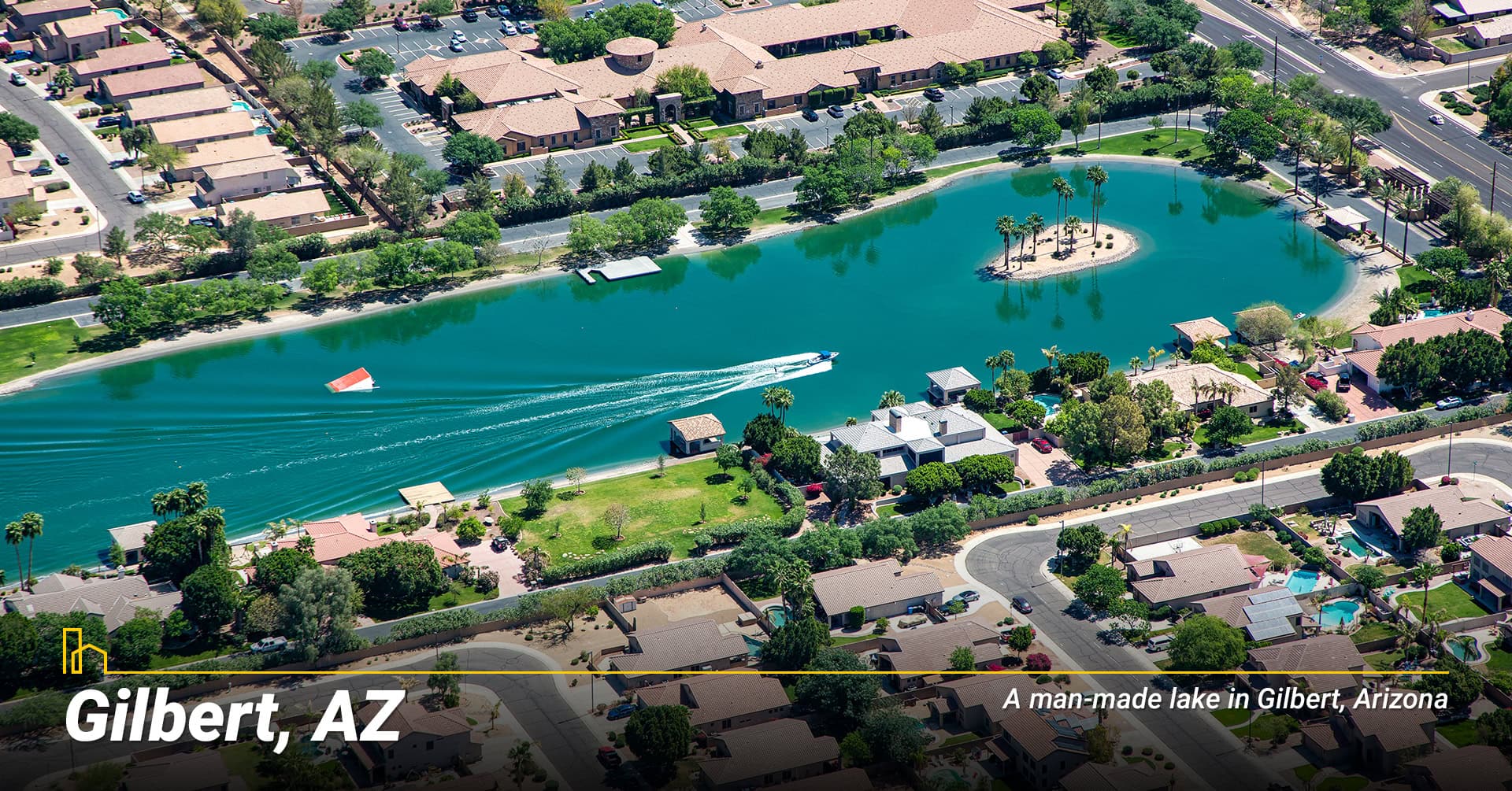
HOMEiA Score: 91/100
- Cost of Living: 18% above the U.S. national average
- Home price to income ratio: $450,000/$96,200 = 4.68 (buying homes is expensive)
- Income to rent ratio: $96,200/$19,200 = 5.01 (renting homes is very affordable)
Gilbert has transformed from an agricultural community into a thriving suburban city. Located in the southeast Valley of the Sun, Gilbert combines family-friendly neighborhoods with modern amenities and economic opportunity. The city consistently ranks among the safest municipalities in Arizona and offers excellent schools, parks, and recreational facilities.
A. Size and Population
Gilbert has a population of approximately 279,569 (2025) spread over a 68-square-mile area. The population density is moderate at about 4,068 people per square mile.
The population grew by approximately 12.5% from 2020 through 2024, significantly above the overall U.S. growth rate, reflecting Gilbert’s appeal as a family-oriented community with strong economic prospects.
B. Median Income, Cost of Living and Housing Market Characteristics
GILBERT MEDIAN HOUSEHOLD INCOME (2025): $145,526
Gilbert Cost of Living, Arizona:
- 12% Higher than the U.S. National Average
- 5% Higher than Phoenix, Arizona
- 35% Lower than San Francisco, California
- 2% Higher than Denver, Colorado
Gilbert Housing Costs
- Median Home Value: $565,000
- Annual Spend for Homeowners: $34,800
- Annual Spend for Renters (Rent & Utilities): $24,708
Gilbert shows a home price-to-income ratio of 4.68, making homebuying expensive though less so than Scottsdale. With an income-to-rent ratio of 5.01, rent is very affordable. Approximately 73.1% of residents own their homes, one of the highest rates in the Phoenix area.
C. Top Neighborhoods in Gilbert, AZ:
- Val Vista Lakes (Average Home Value: $550,000 to $1.5+ million)
An expert-planned community centered around a 76-acre lake system with a private beach club, tennis courts, and walking trails.
- Power Ranch (Average Home Value: $400,000 to $900,000)
A popular family-friendly community with lakes, parks, swimming pools, and an extensive trail system that hosts regular community events.
- Seville (Average Home Value: $500,000 to $1.5+ million)
An upscale golf community featuring the Seville Golf & Country Club with Mediterranean-inspired architecture and resort amenities.
- Morrison Ranch (Average Home Value: $450,000 to $1+ million)
Distinguished by white rail fences, tree-lined streets, and green belts, this community maintains a rural aesthetic while offering modern amenities.
- Circle G/Agritopia (Average Home Value: $500,000 to $1.2+ million)
An innovative community built around an urban farm with farm-to-table dining, community gardens, and a walkable village atmosphere.
3 Most Affordable and Safe Neighborhoods to Live in San Antonio, Texas
With an advantageous tax structure, a low cost of living, and a warm, diversified climate, San Antonio blends financial attractiveness and cultural life, making it a dynamic and cheap Texas destination…
D. Employment Prospects
The unemployment rate in Gilbert is a low 2.5% (January 2025), with a poverty rate of just 5.13%, both well below state and national averages.
Top employers include Banner Health, Dignity Health, GoDaddy, Deloitte, and Northrop Grumman, with growing sectors in healthcare, technology, and financial services.
The average commute time is 32 minutes, slightly above the national average, with many residents commuting to nearby cities though Gilbert’s own job market continues to expand.
E. Unique Attributes and Lifestyle
Gilbert offers a family-focused lifestyle with modern amenities:
- Heritage District: The revitalized downtown area hosts restaurants, shops, and entertainment venues with regular farmers markets, concerts, and seasonal events.
- Parks and Recreation: Over 30 parks, including the 272-acre Riparian Preserve at Water Ranch, combine water recreation, wildlife habitat, and an astronomical observatory. The community features more than 135 miles of bike trails.
- Food Scene: Gilbert has emerged as a culinary destination with restaurant clusters like the Heritage District’s “restaurant row.”
- Family Activities: Numerous family-friendly attractions including TopGolf, Main Event Entertainment, and regular community events like the Gilbert Days Festival.
- Agritopia: A unique 160-acre development preserving agricultural heritage with an 11-acre urban farm integrated with residential neighborhoods.
F. Education
Gilbert is served primarily by three school districts: Gilbert Public Schools, Higley Unified School District, and Chandler Unified School District. Notable public high schools include Gilbert Classical Academy, Higley High School, and Campo Verde High School.
Higher education options include Chandler-Gilbert Community College, Park University’s Gilbert Campus, and proximity to Arizona State University’s Polytechnic Campus.
The high school graduation rate is approximately 94%, well above the U.S. national average, with about 49.8% of adults holding college degrees.
G. Healthcare and Safety
Gilbert is served by Mercy Gilbert Medical Center, Banner Gateway Medical Center, and Banner MD Anderson Cancer Center.
The city has just 0.98 violent crimes per 1,000 residents and 12.6 property crimes per 1,000 residents, both well below state and national medians. Gilbert consistently ranks among the safest cities nationally.
The 10 Cheapest Places to Live in Texas (updated)
They say everything is bigger in Texas, and for good reason. From some of America’s largest and active metropolitan cities to the host of recreational activities for people of all ages across the state to the many bigger-than-life personalities who call Texas home, Texas has plenty to offer for everyone. here’s the list of 10 lowest cost of living places…
7. Scottsdale, AZ

HOMEiA Score: 93/100
- Cost of Living: 33% above the U.S. national average
- Home price to income ratio: $651,000/$105,733 = 6.15 (buying homes is expensive)
- Income to rent ratio: $105,733/$27,600 = 3.82(renting homes is affordable)
Scottsdale tops our list as the premier city to live in Arizona for 2025. Located in the eastern part of Maricopa County adjacent to Phoenix, Scottsdale offers an upscale desert lifestyle with abundant sunshine, luxury amenities, and beautiful natural surroundings. Known for its high-end resorts, golf courses, and vibrant arts scene, Scottsdale combines sophisticated urban living with easy access to outdoor recreation.
A. Size and Population
Scottsdale has a population of about 246,068(2025) spread over a 184-square-mile area. The population density is low at 1,337 people per square mile, contributing to the city’s spacious feel.
The population grew by approximately 1.73% from 2020 through 2025, slightly above the overall U.S. growth rate. This steady growth reflects the city’s continued appeal as a relocation destination, particularly for professionals, families, and retirees from higher-cost states.
B. Median Income, Cost of Living, and Housing Market Characteristics
SCOTTSDALE MEDIAN HOUSEHOLD INCOME (2024): $105,733
Scottsdale Cost of Living, Arizona:
- 33% Higher than the U.S. National Average
- 15% Higher than Phoenix, Arizona
- 25% Lower than San Francisco, California
- 10% Higher than Denver, Colorado
Scottsdale Housing Costs
- Median Home Value: $651,000
- Annual Spend for Homeowners: $48,000
- Annual Spend for Renters (Rent & Utilities): $27,600
Scottsdale has a home price-to-income ratio of 3.86, slightly above the U.S. average of 3.82, making homebuying expensive. However, with an income-to-rent ratio of 6.11, rent remains affordable. Approximately 84.7% of residents own their homes.
C. Top Neighborhoods in Scottsdale, AZ:
- North Scottsdale (Average Home Value: $900,000 to $5+ million)
North Scottsdale features luxury expert-planned communities like DC Ranch and Silverleaf with stunning desert landscapes, mountain views, and world-class golf courses.
- Old Town Scottsdale (Average Home Value: $500,000 to $2+ million)
The historic heart of Scottsdale offers a vibrant urban experience with walkable streets, art galleries, restaurants, and nightlife. Housing ranges from historic homes to modern condominiums.
- Gainey Ranch (Average Home Value: $750,000 to $3+ million)
This exclusive expert-planned community features a mix of housing styles with access to the Gainey Ranch Golf Club, tennis facilities, and a resort-like atmosphere with 24-hour security.
- McCormick Ranch (Average Home Value: $600,000 to $2+ million)
One of Scottsdale’s established expert-planned communities, known for its lakes, parks, and extensive pathway system with easy access to shopping and dining.
- Grayhawk (Average Home Value: $550,000 to $2.5+ million)
A popular expert-planned community featuring two golf courses, parks, and recreational amenities with an active community atmosphere.
The Cost of Living in California vs Texas (Updated)
Both California and Texas have not only the largest populations but the largest habitable landmass of any of the U.S. states. This means there are not a lot of statements that can be made which represent either state in totality. We’ll let you know here the general cost factors to consider when making a decision to relocate to either state…
D. Employment Prospects
The unemployment rate in Scottsdale is approximately 2.8% (January 2025), below both U.S. national and Arizona rates. The poverty rate is 7.13%, well below state and national averages.
Top employers include HonorHealth, CVS Health, Mayo Clinic, General Dynamics Mission Systems, and Vanguard. The city has a strong presence in the healthcare, financial services, technology, and hospitality sectors.
The average commute time is just 22 minutes, below the national average, with many residents working within Scottsdale or nearby Phoenix.
E. Unique Attributes and Lifestyle
Scottsdale offers a blend of sophisticated urban amenities and natural desert beauty:
- Arts and Culture: Home to more than 100 art galleries and studios, primarily in the Old Town’s Arts District, with regular ArtWalk events and the Scottsdale Museum of Contemporary Art.
- Outdoor Recreation: The 30,500-acre McDowell Sonoran Preserve offers over 225 miles of trails for hiking, mountain biking, and horseback riding. Pinnacle Peak Park and Camelback Mountain provide challenging hikes with panoramic views.
- Golf Paradise: Features more than 200 golf courses in the greater area, including the world-renowned TPC Scottsdale, home of the Waste Management Phoenix Open.
- Shopping and Dining: Scottsdale Fashion Square is one of the Southwest’s largest shopping destinations. The dining scene ranges from casual southwestern fare to high-end gourmet restaurants.
- Resort Lifestyle: Known for luxury resorts and spas, including the Fairmont Scottsdale Princess, The Phoenician, and Four Seasons Resort.
F. Education
There are 76 public schools and 59 private schools in Scottsdale. The Scottsdale Unified School District serves most of the city, with several schools receiving “A” ratings from the Arizona Department of Education. Notable public high schools include Desert Mountain High School, Chaparral High School, and Basis Scottsdale.
Higher education institutions include Scottsdale Community College, Mayo Clinic Alix School of Medicine, and satellite campuses of Arizona State University.
The high school graduation rate is approximately 92%, above the U.S. national average. About 58% of adults hold college degrees, well above the national average of 33%.
G. Healthcare and Safety
Scottsdale is served by several major healthcare systems, including HonorHealth with multiple campuses, Mayo Clinic, and Phoenix Children’s Hospital.
The city has 3.75 violent crimes per 1,000 residents and 19.8 property crimes per 1,000 residents, both significantly below state and national medians. Scottsdale consistently ranks as one of Arizona’s safest cities.
Conclusion
Arizona offers diverse living experiences from Scottsdale’s upscale desert lifestyle to Flagstaff’s four-season mountain environment. Each city presents unique advantages in employment, education, recreation, and culture. While housing affordability remains challenging, particularly in Flagstaff and Scottsdale, Arizona continues to attract newcomers with its sunshine, outdoor recreation, and growing economy. Whether you seek family-friendly suburbs, vibrant university towns, or cultural hubs, the Grand Canyon State provides compelling options for southwestern living with modern amenities.
30 Best Packing Tips for Moving to a New City
How do you get everything safely from Point A to Point B on a tight schedule? With a lot of planning. Here are our best tips to make the process of moving to a new city as smooth as possible…
Gwen Parrish is a versatile writer based in Arizona, specializing in copywriting, editing, and proofreading. With a keen eye for detail and a talent for crafting compelling narratives, she helps individuals and businesses bring their ideas to life. Gwen’s work is influenced by the vibrant desert surroundings she calls home, providing a unique perspective in her creative process. Whether polishing a manuscript, developing engaging content, or refining a message for clarity, she approaches every project professionally and passionately. Gwen also enjoys reading, hiking, and spending time with her family and dogs.
HOMEiA is a city guide site where visitors can find detailed information about communities of interest. HOMEiA’s City Guides, created in partnership with local writers and editors, are curated lists of the best, safest, and most affordable places to live. The guides feature the HOMEiA Score, a proprietary index that rates communities on such factors as housing costs, education, employment, etc.
HOMEiA.com aims to be the premier site for people planning to relocate, providing them with insightful content and connecting them with skilled real estate professionals.
We also empower real estate professionals to establish or strengthen their web presence by highlighting their experience, knowledge and achievements. If you’re selected to join our list of certified real estate professionals, you will distinguish yourself from your peers — and earn HOMEiA’s support.
If you believe in HOMEiA’s mission, please share our website with others.

